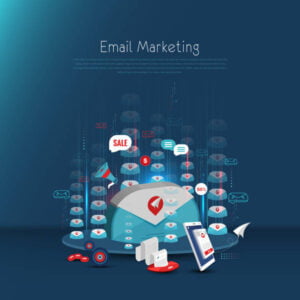In today’s digital age, marketing automation has reshaped how we interact with customers. As a seasoned marketer, I’ve seen its significant impact on lead nurturing, personalizing customer experiences, and driving growth. This technology has become a cornerstone for businesses across the spectrum.
For both small business owners and marketing executives at large corporations, the essence of successful marketing automation is consistent. It’s about setting clear goals that align with your business aims, understanding your audience deeply, and using the right automation tools. By doing so, you can open up new possibilities and craft a seamless, tailored experience for your customers.
Key Takeaways
- Marketing automation is a powerful tool for streamlining marketing tasks and improving customer engagement.
- Defining clear goals and objectives is crucial for developing an effective marketing automation strategy.
- Identifying and understanding your target audience is essential for delivering personalized, relevant content.
- Choosing the right marketing automation platform can significantly impact the success of your campaigns.
- Mapping customer journeys and delivering personalized content are key to building strong customer relationships.
Define Goals, Objectives, and Target Audience
Before starting a marketing automation strategy, it’s vital to define clear marketing automation goals and objectives. These goals can include lead generation, customer acquisition, or reducing shopping cart abandonment. It’s essential that these objectives align with the brand’s overarching business goals and priorities.
Understanding the target audience is crucial for an effective marketing automation strategy. Brands must conduct market research and analyze customer data to uncover who their audience is, what they need, and how they interact with the brand. This knowledge allows for audience segmentation and the creation of personalized content that speaks to each group.
Aligning Goals with Business Objectives
It’s vital to ensure that marketing automation goals align with the brand’s business objectives. This alignment ensures marketing efforts support the company’s strategic goals. By knowing the business priorities, marketers can set marketing objectives that aid these goals.
Identifying and Understanding the Target Audience
Successful marketing automation hinges on a deep understanding of the target audience. Brands should use market research and customer data analysis to uncover the audience’s needs, behaviors, and preferences. This insight enables audience segmentation and the creation of personalized content that connects with each segment.
“The key to effective marketing automation is understanding your target audience and aligning your goals with their needs and behaviors.”
Choose the Right Marketing Automation Platform
Choosing the right marketing automation platform is key to your marketing strategy’s success. It’s vital to assess the features, functionality, and cost of different platforms. This ensures they match your business goals and audience.
Popular Marketing Automation Software
Top marketing automation platforms include HubSpot, Adobe Marketo Engage, Salesforce Marketing Cloud, Oracle Eloqua, ActiveCampaign, Keap, GetResponse, Customer.io, Dynamics 365 Marketing, and Act-On. Each platform offers distinct capabilities and pricing, catering to businesses of all sizes.
Evaluating Features, Functionality, and Cost
When assessing marketing automation platforms, consider these key factors:
- Features: Essential capabilities include email marketing, lead management, customer segmentation, and campaign management.
- Functionality: Integration with existing systems, content personalization, and comprehensive reporting and analytics are vital.
- Cost: Evaluate the pricing structure and potential return on investment (ROI) to match your budget and marketing goals.
| Platform | Key Features | Functionality | Cost |
|---|---|---|---|
| HubSpot | Email marketing, lead management, customer segmentation | Integrations, personalization, reporting and analytics | $50 – $3,200 per month |
| Adobe Marketo Engage | Campaign management, lead scoring, account-based marketing | Data integration, predictive analytics, AI-powered personalization | Custom pricing |
| Salesforce Marketing Cloud | Email marketing, mobile marketing, social media management | CRM integration, journey mapping, real-time reporting | $400 – $12,000 per month |
By thoughtfully evaluating the features, functionality, and cost of marketing automation platforms, brands can make a well-informed choice. This ensures they select a solution that meets their specific needs and budget.
mapping customer journeys and delivering personalized content
Mapping the customer journey is vital for crafting an omnichannel experience that fosters connection, trust, and loyalty. Customer journey mapping helps brands grasp the various stages of the customer lifecycle. It shows how to use marketing automation to connect with customers at each stage.
Delivering the right message at the right time in the customer journey boosts engagement and loyalty. Personalization is crucial in marketing automation strategies. It makes content more relevant to customers’ specific needs and preferences.
Effective customer segmentation and dynamic content are essential for personalized experiences. Brands use customer data to craft content that speaks to each customer. This approach builds a deeper connection, increases engagement, and drives loyalty.
| Personalization Tactics | Benefits |
|---|---|
| Personalized product recommendations | Increased sales and customer engagement |
| Customized email content and subject lines | Higher open and click-through rates |
| Targeted web content and landing pages | Improved website conversion rates |
| Personalized push notifications and SMS messages | Enhanced customer experience and brand loyalty |
By integrating customer journey mapping and personalized content into marketing automation workflows, brands can offer a seamless, engaging, and customized experience. This approach drives customer loyalty and business success.
“Personalization is not just a tactic – it’s a strategic imperative for brands to stay competitive and meet evolving customer expectations.” – Marketing Automation Expert
Set Up Automated Workflows and marketing automation strategies
Automated workflows are crucial for successful marketing automation strategies. They allow brands to send timely, targeted, and personalized messages to customers based on their actions. Actions can include website visits, email opens, or cart abandonment. These workflows can include features like email drip campaigns, lead scoring, and lead nurturing, enhancing customer engagement and retention.
Aligning automated workflows with your business goals and target audience is key. This ensures the messages and content delivered are truly valuable and relevant to your customers. Analyzing the performance of these workflows helps refine and optimize marketing strategies for better results.
Effective marketing automation strategies use various automated workflows to boost customer engagement and retention:
- Triggered Messages: Automated messages triggered by specific customer actions, such as welcome emails, abandoned cart reminders, or post-purchase follow-ups.
- Drip Campaigns: Automated email sequences designed to nurture leads and guide them through the sales funnel.
- Lead Scoring: Automated systems that assign scores to leads based on their engagement and behaviors, helping you prioritize and engage with the most promising prospects.
- Lead Nurturing: Automated processes that provide relevant content and communication to leads, building trust and moving them closer to conversion.
By using these marketing automation workflows, brands can offer a seamless, personalized customer experience. This drives engagement, retention, and ultimately, business growth.
| Workflow Type | Key Benefits |
|---|---|
| Triggered Messages | Timely, personalized communication that responds to customer actions and enhances engagement. |
| Drip Campaigns | Nurture leads through the sales funnel with a series of relevant, automated messages. |
| Lead Scoring | Prioritize and focus sales efforts on the most promising leads, improving conversion rates. |
| Lead Nurturing | Build trust and maintain momentum with leads through valuable, automated content and outreach. |
Mastering marketing automation workflows allows brands to deliver a more personalized, engaging, and effective customer experience. This leads to customer engagement and customer retention.
“Automation is key to scaling your marketing efforts and delivering personalized experiences that keep customers coming back.”
Conclusion
In the dynamic world of marketing, marketing automation has become a pivotal tool for businesses aiming to improve customer interaction, increase customer loyalty, and foster lasting business growth. By setting clear marketing strategy goals and matching them with the specific needs of their audience, companies can fully harness marketing automation’s potential.
Choosing the ideal marketing automation platform is crucial for success. It must blend well with current systems and offer a wide range of features. By understanding customer journeys and delivering tailored content, businesses can build stronger connections. This approach creates trust and loyalty, key for long-term success.
Implementing a thoughtful marketing automation strategy helps businesses optimize their marketing efforts, boost customer interaction, and achieve sustainable business growth. By leveraging automation, brands can allocate more time and resources to their core competencies. This enables them to provide outstanding experiences, ensuring customer retention and loyalty.





